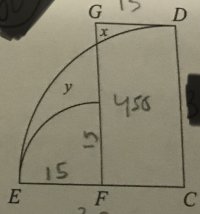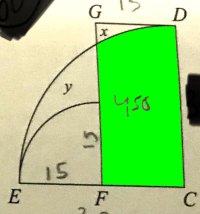In the diagram, CD = CE = 30 and F is the midpoint of CE. Two quarter circles are drawn: one with centre C and passing through D and E, and the other with centre F and passing through E. Let x be the area of the region that is inside rectangle GDCF and outside the larger quarter circle. Let y be the area that is inside the larger quarter circle, outside the smaller quarter circle, and outside rectangle GDCF. Let d be the positive difference between x and y. What is the integer closest
to d?
I tried solving it so the numbers on diagram might be wrong.

to d?
I tried solving it so the numbers on diagram might be wrong.

Last edited by a moderator:

